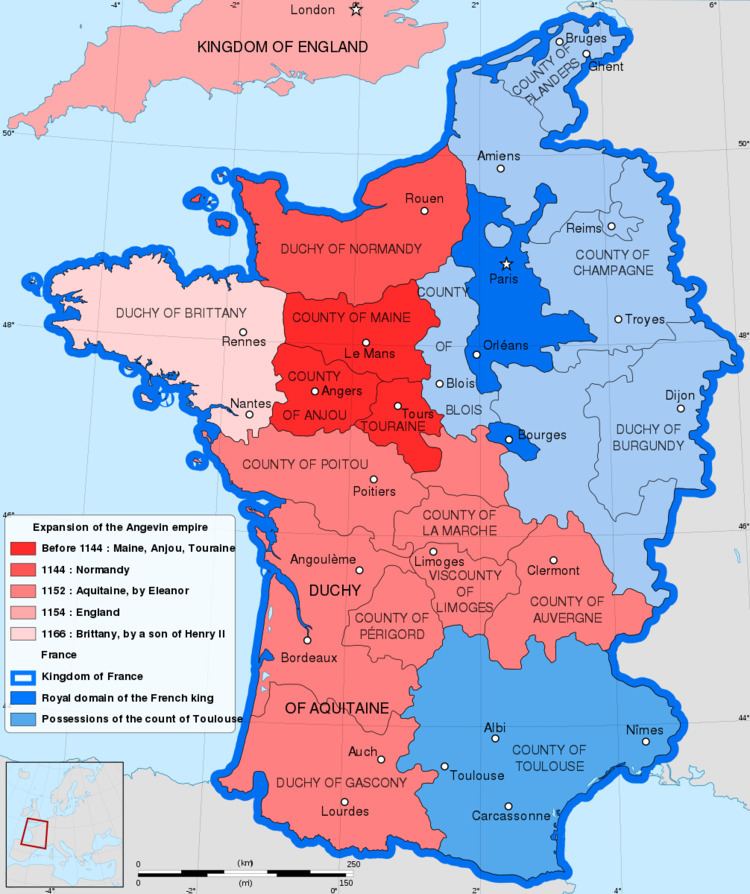 | ||
The Duke of Aquitaine (Occitan: Duc d'Aquitània, French: Duc d'Aquitaine, [dyk dakitɛn]) was the ruler of the ancient region of Aquitaine (not to be confused with modern-day Aquitaine) under the supremacy of Frankish, English, and later French kings.
Contents
- Coronation
- Dukes of Aquitaine under Frankish kings
- Restored dukes of Aquitaine under Frankish kings
- House of Poitiers Ramnulfids
- House of Auvergne
- House of Poitiers Ramnulfids restored 927932
- House of Rouergue
- House of Capet
- House of Poitiers Ramnulfids restored 9621152
- House of Plantagenet
- Plantagenet rulers of Aquitaine
- Valois and Bourbon dukes of Aquitaine
- References
As successor states of the Visigothic Kingdom (418–721), Aquitania (Aquitaine) and Languedoc (Toulouse) inherited both Visigothic laws and Roman Law, which together allowed women more rights than their contemporaries would enjoy until the 20th century. Particularly under the Liber Judiciorum as codified 642/643 and expanded by the Code of Recceswinth in 653, women could inherit land and title and manage it independently from their husbands or male relations, dispose of their property in legal wills if they had no heirs, represent themselves and bear witness in court from the age of 14, and arrange for their own marriages after the age of 20. As a consequence, male-preference primogeniture was the practiced succession law for the nobility.
Coronation
The Merovingian kings and dukes of Aquitaine had their capital at Toulouse. The Carolingian kings used different capitals situated further north. In 765, Pepin the Short bestowed the captured golden banner of the Aquitainian duke, Waiffre, on the Abbey of Saint Martial in Limoges. Pepin I of Aquitaine was buried in Poitiers. Charles the Child was crowned at Limoges and buried at Bourges. When Aquitaine briefly asserted its independence after the death of Charles the Fat, it was Ranulf II of Poitou who took the royal title. In the late tenth century, Louis the Indolent was crowned at Brioude.
The Aquitainian ducal coronation procedure is preserved in a late twelfth-century ordo (formula) from Saint-Étienne in Limoges, based on an earlier Romano-German ordo. In the early thirteenth century a commentary was added to this ordo, which emphasised Limoges as the capital of Aquitaine. The ordo indicated that the duke received a silk mantle, coronet, banner, sword, spurs, and the ring of Saint Valerie.
Dukes of Aquitaine under Frankish kings
Merovingian kings are in boldface.
Restored dukes of Aquitaine under Frankish kings
The Carolingian kings again appointed Dukes of Aquitaine, first in 852, and again since 866. Later, this duchy was also called Guyenne.
House of Poitiers (Ramnulfids)
House of Auvergne
House of Poitiers (Ramnulfids) restored (927–932)
House of Rouergue
House of Capet
House of Poitiers (Ramnulfids) restored (962–1152)
From 1152, the Duchy of Aquitaine was held by the Plantagenets, who also ruled England as independent monarchs and held other territories in France by separate inheritance (see Plantagenet Empire). The Plantagenets were often more powerful than the kings of France, and their reluctance to do homage to the kings of France for their lands in France was one of the major sources of conflict in medieval Western Europe.
House of Plantagenet
Richard the Lionheart was outlived by his mother Eleanor of Aquitaine. In 1189, she acted as regent for the Duchy while he was on crusade — a position he resumed on his return to Europe.
Plantagenet rulers of Aquitaine
In 1337, King Philip VI of France reclaimed the fief of Aquitaine from Edward III, King of England. Edward in turn claimed the title of King of France, by right of his descent from his maternal grandfather King Philip. This triggered the Hundred Years' War, in which both the Plantagenets and the House of Valois claimed the supremacy over Aquitaine due to the King of France.
In 1360, both sides signed the Treaty of Bretigny, in which Edward renounced the French crown but remained sovereign Lord of Aquitaine (rather than merely duke). However, when the treaty was broken in 1369, both these English claims and the war resumed.
In 1362, King Edward III, as Lord of Aquitaine, made his eldest son Edward, Prince of Wales, Prince of Aquitaine.
In 1390, King Richard II, son of Edward the Black Prince appointed his uncle John of Gaunt Duke of Aquitaine. This grant expired upon the Duke's death, and the dukedom reverted to the Crown. Regardless, due to Henry Bolingbroke's seizure of the crown, he still came into possession of the dukedom.
Henry V continued to rule over Aquitaine as King of England and Lord of Aquitaine. He invaded France and emerged victorious at the siege of Harfleur and the Battle of Agincourt in 1415. He succeeded in obtaining the French crown for his family by the Treaty of Troyes in 1420. Henry V died in 1422, when his son Henry VI inherited the French throne at the age of less than a year; his reign saw the gradual loss of English control of France.
Valois and Bourbon dukes of Aquitaine
The Valois kings of France, claiming supremacy over Aquitaine, granted the title of duke to their heirs, the Dauphins.
With the end of the Hundred Years' War, Aquitaine returned under direct rule of the king of France and remained in the possession of the king. Only occasionally was the duchy or the title of duke granted to another member of the dynasty.
The Infante Jaime, Duke of Segovia, son of Alfonso XIII of Spain, was one of the Legitimist pretenders to the French throne; as such he named his son, Gonzalo, Duke of Aquitaine (1972–2000); Gonzalo had no legitimate children.
